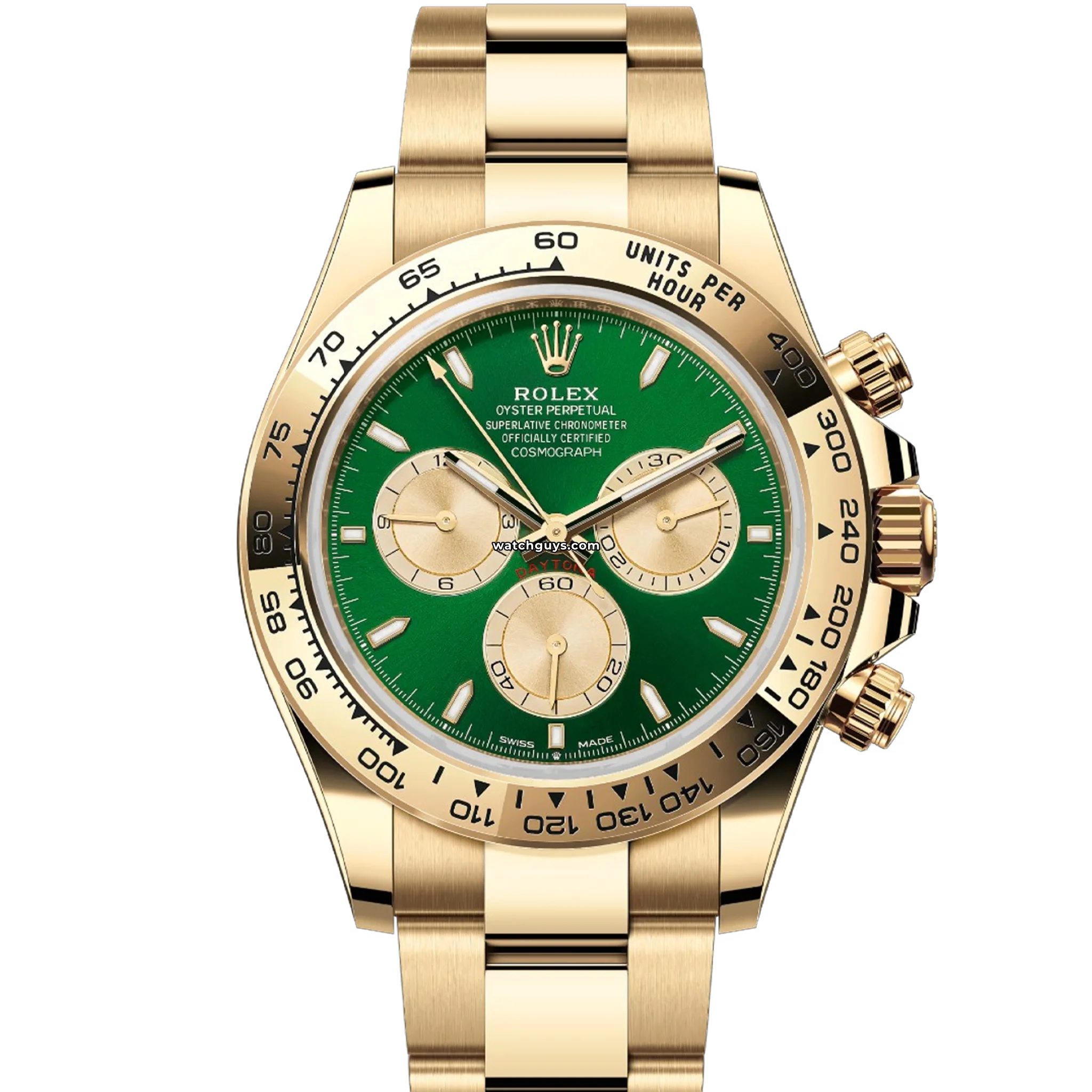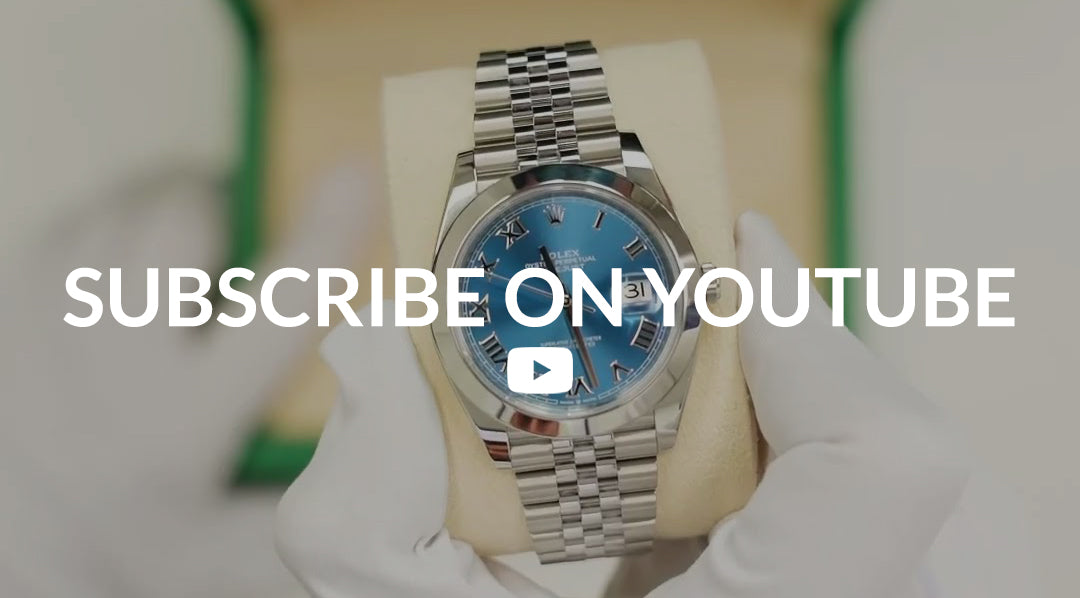Rolex Daytona 'John Mayer' 116508 vs 126508
John Mayer 2.0 Differences
The Rolex Cosmograph Daytona is an icon among luxury watches, and the green-dialed yellow gold variant, nicknamed the “John Mayer” Daytona, has become legendary among collectors. Like many coveted Rolex Watches, it balances technical mastery with jaw-dropping visuals. In 2025, Rolex released a new reference 126508 – quickly dubbed “John Mayer 2.0” – as the modern successor to the original green-dial 116508.
This guide compares the two models in technical detail, historical context, and investment value. We explore how the 126508 builds upon the 116508's legacy with subtle design tweaks and a new movement, and examine what these changes mean for collectors: from case design and dial differences to market prices and long-term prospects. By the end, you’ll have a clear understanding of how the new 126508 stacks up against the famed 116508, and which reference might be better suited for your collection, daily wear, or investment goals.

The History of the John Mayer Watch
The story of the green-dial Daytona begins in 2016, when Rolex introduced the 116508 in 18k yellow gold with a metallic green sunburst dial. This release flew under the radar until 2019, when musician and watch collector John Mayer publicly raved about the green Daytona’s appeal. Mayer noted it was a “sleeper” pick that had been overlooked: “How does nobody notice this?” he exclaimed. Mayer would later declare the model as one that collectors would regret missing out on.
Since then, the 116508 has been indelibly nicknamed the “John Mayer” Daytona – not due to any official endorsement or limited edition, but purely because Mayer’s praise catapulted. Prices on the secondary market jumped as enthusiasts rushed to acquire the model Mayer had anointed. The watch’s signature look – 18k yellow gold case and Oyster bracelet matched with a glossy green dial and red “Daytona” text – became instantly iconic.

Importantly, the 116508 wasn’t a one-off or limited production; it was part of the regular Daytona lineup from 2016 until 2023, when Rolex discontinued it as they prepared to roll out a new generation. The model’s discontinuation in 2023 only intensified its legend as its value spiked in just weeks. Collectors viewed the original John Mayer Daytona as a modern classic, and its sudden rarity added fuel to the hype. This was the stage onto which Rolex would eventually introduce the 126508 in 2025 – a watch that had big shoes to fill, given the fervent following of its predecessor.
Physical Differences and Updates
Though similar at first glance, the Rolex Daytona 116508 and 126508 differ in multiple technical and aesthetic ways. From the case to the movement, here’s what’s changed in the 2025 “John Mayer 2.0.”
Dial Differences
Visually, the biggest change is the dial. The original 116508 features a rich sunburst Rolex green with a metallic radiating finish. It had tone-on-tone green sub-dials (chronograph counters that matched the dial color) with subtle red accents. The 126508, in contrast, introduces contrasting gold subdials with a brighter green dial, giving it a more vintage-inspired look reminiscent of Paul Newman Daytonas.
Rolex also refined the markers and layout—the hour markers are slimmer and slightly longer, an update applied across the new Daytona generation. These applied indices are still crafted in gold and filled with Rolex’s Chromalight luminous paint, but their profile is more delicate, which, along with slightly more space on the dial, gives a cleaner look. The overall look is cleaner and more contemporary while maintaining its luxurious appeal.


Rolex Daytona 116508 (left) with tone-on-tone green sub-dials and Rolex Daytona 126508 (right) featuring contrasting gold sub-dials — two generations showcasing distinct interpretations of the iconic green dial aesthetic.
Technical Comparison: Rolex Daytona 116508 vs. 126508
| Feature | Rolex Daytona 116508 | Rolex Daytona 126508 |
|---|---|---|
| Case Design | 40mm yellow gold case, approx. 12.2mm thick; classic lug shape and proportions. | Same diameter, but slimmer at 11.9mm; tapered lugs and refined case profile for improved wrist presence. |
| Bezel and Crown | 18k yellow gold tachymeter bezel; traditional fit with standard Daytona pusher layout. | Same bezel material and font, but more integrated into case with smoother transitions; improved machining tolerances for crown and pushers. |
| Bracelet and Clasp | Solid-link Oyster bracelet in yellow gold; standard end link width and articulation; Oysterlock clasp with Easylink extension. | Tapered end links and refined link articulation for better comfort and flow; same clasp construction with improved ergonomics. |
| Movement | Caliber 4130 – in-house chronograph with 72h power reserve, column wheel, Parachrom hairspring. | Caliber 4131 – adds Chronergy escapement, Paraflex shock absorbers, and an improved rotor for greater durability and efficiency. |
Both movements remain chronometer-certified and offer a 72-hour power reserve, but the 126508's Caliber 4131 benefits from updated materials and architecture designed to extend performance and reduce service frequency.
Prices and Market Value
One of the most dramatic differences between the original “John Mayer” Daytona and the new one is their current market price, both retail and secondary. Rolex has substantially raised the official retail price for the new model, and on the secondary market these watches command hefty premiums. Let’s break down the numbers (as of mid-2025):
Retail Prices
| Model | Retail Price (USD) | Status |
|---|---|---|
| Rolex Daytona 116508 “John Mayer” | $38,700 | Discontinued in 2023 |
| Rolex Daytona 126508 “John Mayer 2.0” | $48,400 | Launched in 2025 |
That’s nearly a $10k increase in list price. Rolex justified this jump partly due to inflation and higher material costs – the price of gold rose ~62% from 2013 to 2023, which factors into a solid gold watch’s cost. But there may also be some “hype tax” baked in, as Rolex knows this dial is in crazy demand.
Secondary Market Prices
| Model | Market Price (USD) | Notes |
|---|---|---|
| Rolex 116508 “John Mayer” | $73,000 | Varies based on condition and full-set status |
| Rolex 126508 “John Mayer 2.0” | $120,000 | Premium pricing for unworn or complete sets |
This means the new 126508 commands a secondary market price nearly 2.5× its retail—a testament to collector demand and market enthusiasm. In contrast, the 116508 has seen slight cooling from its peak (~$85–$90K) after being discontinued but still holds strong value due to its legacy.

Investment Potential
How have these watches performed as investments, and what are their prospects going forward? The Rolex Daytona line in general has a reputation for holding or increasing in value, and the green-dial John Mayer editions are prime examples. Let’s consider each reference. Note: This is not financial advice. Always conduct your own research before making investment decisions.
Rolex Daytona 116508 “John Mayer”
Since its release in 2016 and John Mayer’s famous endorsement in 2019, the 116508 has seen extraordinary appreciation. Originally retailing around $35,000–$38,700, it now fetches ~$73,000 on the secondary market. That’s nearly a 2× return, outperforming many traditional investments.
When the 116508 was discontinued in 2023, prices surged nearly 20% overnight. While values have cooled slightly post-126508 release, its discontinued status and origin story make it a modern collector classic with strong long-term upside.
Rolex Daytona 126508 “John Mayer 2.0”
The new 126508 has skyrocketed in value right out of the gate. With a retail price of $48,400, it’s already selling on the secondary market for around $120,000—an immediate 2.3× markup. That’s a massive return for those lucky enough to acquire one at retail.
However, at current market levels, new buyers are betting on continued scarcity and collector interest. If Rolex produces this model in limited numbers or discontinues it early, prices could rise further. If not, there may be some softening as supply increases.

Long-Term Outlook
| Model | Outlook Summary |
|---|---|
| Rolex Daytona 116508 | Proven track record, strong historical value, and collector appeal. Low risk, moderate future growth. |
| Rolex Daytona 126508 | High potential but higher entry point. Great upside if scarcity holds, but short-term volatility is possible. |
Ultimately, both references are among the top-performing modern Rolexes on the market. While the 116508 is a “proven blue-chip,” the 126508 is a high-profile newcomer with momentum and modern technical advantages.
Impact of the 126508 Release on the 116508 Market
When Rolex introduced the 126508 “John Mayer 2.0” in 2025, the market had a strong reaction, not only to the new release, but also in how it affected the perception and pricing of the original 116508.
Market Impact & Collectibility Comparison
| Aspect | Rolex Daytona 116508 | Rolex Daytona 126508 |
|---|---|---|
| Pre-126508 Market Price | $85,000–$90,000 | Not yet released |
| Post-Launch Price (2025) | Dropped to ~$73,000 | Launched at ~$120,000 on the secondary market |
| Market Sentiment | Preferred by purists; associated directly with John Mayer’s endorsement and original green-on-green dial | Favored by collectors seeking contrast, vintage cues, and the latest Rolex tech |
| Collectibility Outlook | Seen as the “OG” John Mayer Daytona; maintains long-term appeal and price floor due to discontinued status | Holds current spotlight with premium market value and cutting-edge movement |
The release of the 126508 didn’t replace the 116508—it cemented the legacy of both. Many collectors now view them as complementary pieces, each telling a distinct chapter in Rolex’s ongoing Daytona saga.
Final Thoughts
Choosing between the 116508 and the 126508 depends on your priorities. The 116508 is the historically significant original with proven value and classic appeal. The 126508 offers modern enhancements, a bolder dial, and cutting-edge movement tech. Both are iconic, highly collectible, and represent Rolex Daytona excellence in different ways.
Whether you’re collecting, investing, or just indulging in horological luxury, either of these green-dial Daytonas earns its place at the top of the Rolex pyramid.





